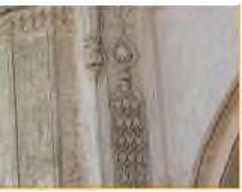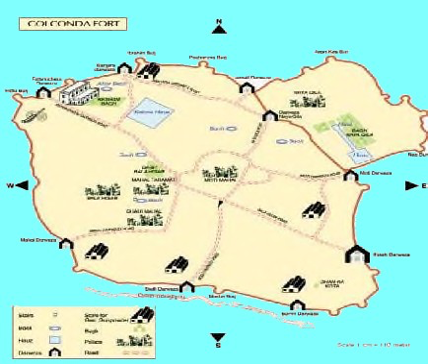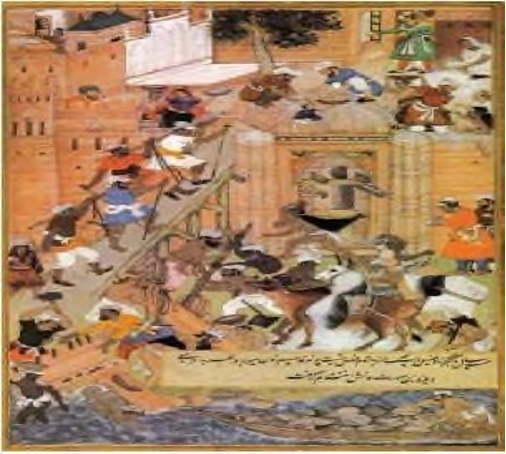NCERT Solutions for Class 5 EVS Chapter 10 Walls tell stories
Find pdf of NCERT Solutions for Class 5 EVS Chapter 10 Walls tell stories prepared by expert teachers. All the questions asked in the exercise of Walls tell stories are solved with the required details.
A Brief Introduction to Chapter 10 Walls tell stories
Chapter 10 Walls tell stories- This chapter tells us the story of the fort of Golconda and how the walls of the Golconda fort which were as big as towns were used by the kings to save their kingdoms. The walls of the forts tell a lot about the history of the Kingdom, This chapter will help us in getting the proper learning about these forts and how they were useful for the kingdoms.
Find pdf of NCERT Solutions for Class 5 EVS Chapter 10 Walls Tell Stories
Page No 88:
Question Think:
· Why were bastions made in the fort wall?
· Why were big holes made in them?
· What difference would be there if you were to look from a straight flat wall or a bastion at a height? How would the soldiers find peeping from the holes in the bastions useful while attacking?
Answer:
· Bastions were made in the fort wall to see at a distance and attack on enemies coming towards the fort from several directions. These rounded and high walls are also called defensive walls.
· Big holes were made in them to watch and shoot at enemies from a distance, keeping the soldiers safe.
· Bastions (Burj) built at a height provide the space for looking on distant places from several directions. With flat walls one could see in one particular direction only and not too far. Soldiers could look in several directions through the holes in the bastions. They could also save themselves while attacking the enemies with the guns or cannons.
Page No 89: Question Think and Discuss:
· How would the fountains have worked?
· What arrangements would have been made in the building for air and light?
· Look carefully at the picture of the beautiful carving on the wall. What kind of tools would have been used for such fine carving?

· We still do not have any electricity at many places in our country. Even at places which do have electricity, imagine what would happen if there was no electricity for one week. What are the things that would be difficult to manage without it?
Answer:
Disclaimer: The questions in this section aim to encourage children to be creative and explore their imaginative skills. Considering this, the answer to the question has not been provided.
Page No 90:
Question Tell and Write: Look carefully at the map of Golconda. On the map, arrows show all the four directions.

· If you are peeping inside from Bodli Darwaza, in which direction from you is Katora Hauz?
· If someone is entering from Banjara Darwaza, in which direction from her is Katora Hauz?
· In which direction will you walk from Bala Hisar to reach Moti Mahal?
· How many gates can you see on the outer walls of the fort?
· Count how many palaces are there in the fort?
· What arrangements for water can you see inside the fort?
· On the map, 1 cm distance is equal to a distance of 110 metres on the ground. Now tell: (a) On the map the distance between Bala Hisar and Fateh Darwaja is_________. On the ground, the distance between the two would be metres. (b) How far is Makai Darwaza from Fateh Darwaza?
· Katora Hauz is in north-west direction if someone is peeping from Bodli Darwaza.
· If someone is entering from Banjara Darwaza, Katora Hauz lies to their south.
· One needs to walk towards east from Bala Hisar to reach Moti Mahal.
· Eight gates can be seen on the outer walls of the fort.
· There are five palaces in the fort.
· We can see tanks (Hauz) and stepwells (Baoli) as arrangements for water inside the fort.
· (a) On the map the distance between Bala Hisar and Fateh Darwaja is 9 cm. On the ground, the distance between the two would be 990 metres. (b) The distance from Makai Darwaza from Fateh Darwaza is 10.5 cm. On ground, the distance is 1155 m. (Note: It’s easy to use the thread on the map to measure curved paths and then measure the thread length on the scale. For the second part, the distance can be measured by the path shown. This makes 14 cm. On ground, the distance becomes 1540 m).
Page No 93:
Question Discuss:
· Have you recently read or heard about any country attacking or going to war with another country?
· Find out what was the reason for this war.
· What kind of weapons were used in this war?
· What kind of destruction was caused because of this?
Disclaimer: The purpose of this section is to make the students interact actively with the world around them. The process calls for critical observance based upon which the students can draw certain conclusions. Considering the sustenance of this process of interaction the answer to these questions have been provided.
Question Find Out:
The big gun that Shreedhar saw was made of bronze.
· Have you seen anything made of bronze? What? Tribal people have been using bronze to make many things since thousands of years. One wonders how they took out copper and tin from the deep mines, melted these metals, and turned them into beautiful things!
· Find out from your elders about some of the things made from bronze that were, or are still used in your house. From its colour try to identify which one of them is made from copper, which from brass, and which from bronze.
Answer:
Disclaimer: The purpose of this section is to make the students interact actively with the people and the world around them. The process calls for critical observance based upon which the students can draw certain conclusions. Considering the sustenance of this process of interaction the answer to these questions have not been provided.
Page No 97:
Question Write:
· What kinds of pots have you seen around you?
· Try to find out from your grandparents about the other kinds of pots and pans they used in their time?
· Have you ever been to some museum or heard about it? What all things are there in a museum?
Answer:
· I have seen several kinds of pots. These are:
Clay pots beautifully painted in brick red in colour that are used to keep drinking water cool
Copper (tamba) pots that are reddish brown in colour Bronze (peetal) pots that are medium brown in colour Brass (kansa) pots that are golden yellow in colour Aluminium pots that are silvery in colour
Iron pots that are greyish in colour
Disclaimer: This question has to be answered based upon one’s own experience. Hence, the same can vary from one student to another.
· Disclaimer: The purpose of this question is to make the students interact actively with the world around them. The process calls for critical observance based upon which the students can draw certain conclusions. Considering the sustenance of this process of interaction the answer to this question has not been provided.
· Museums are the places where we can see very old things being preserved with great care. By seeing these things, we can know about our past very well. These excavated things may be pots, jewellery and utensils used by the people of those times for eating and cooking the food. The weapons used by the warriors in the past and some pieces of art such as painting, stone carving could also be seen in the museum.
Page No 98: Question Look at the Painting:
This painting is 500 years old. It shows Agra fort being constructed.
What kinds of work are people doing? How many men and women are working? See, how they are taking the huge pillar up along the slope? Is it easier to lift a heavy thing straight up or along a slope? Were you able to see the man carrying water in a mashak (leather bag)?

Answer:
Disclaimer: The questions in this section aim to encourage children to be creative and explore their imaginative skills. Considering this, the answer to the question has not been provided.
Question What We Have Learnt:
· Sangeeta thinks it is useless to keep old things in a museum. How would you convince her that it is important to have a museum?
· Why do you think the chapter is named, ‘Walls Tell Stories’?
Answer:
Disclaimer: The questions in this section aim to encourage children to be creative and explore their imaginative skills. Considering this, the answer to the question has not been provided.